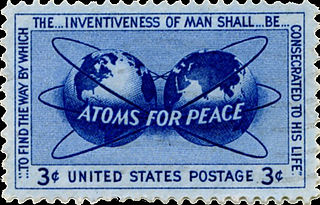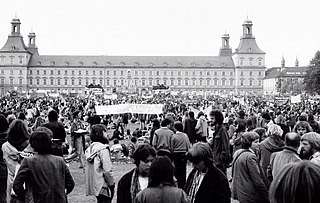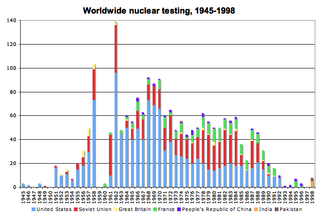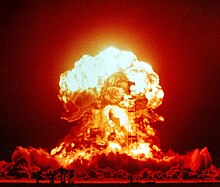

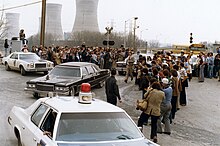
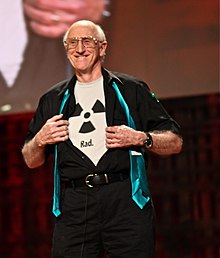
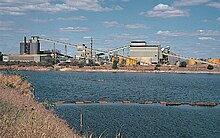
This is a list of books about nuclear issues. They are non-fiction books which relate to uranium mining, nuclear weapons and/or nuclear power.
Contents
- The Algebra of Infinite Justice (2001)
- American Prometheus: The Triumph and Tragedy of J. Robert Oppenheimer (2005)
- The Angry Genie: One Man's Walk Through the Nuclear Age (1999)
- The Atom Besieged: Extraparliamentary Dissent in France and Germany (1981)
- Atomic Obsession: Nuclear Alarmism From Hiroshima to Al-Qaeda (2010)
- The Bells of Nagasaki (1949)
- Brighter than a Thousand Suns: A Personal History of the Atomic Scientists (1958)
- Britain, Australia and the Bomb (2006)
- Brittle Power: Energy Strategy for National Security (1982)
- Canada’s Deadly Secret: Saskatchewan Uranium and the Global Nuclear System (2007)
- Carbon-Free and Nuclear-Free (2007)
- Chernobyl: Consequences of the Catastrophe for People and the Environment (2009)
- Chernobyl. Vengeance of peaceful atom. (2006)
- The Cold and the Dark: The World after Nuclear War (1984)
- Command and Control (book) (2013)
- Confronting the Bomb: A Short History of the World Nuclear Disarmament Movement (2009)
- Conservation Fallout: Nuclear Protest at Diablo Canyon (2006)
- Contesting the Future of Nuclear Power (2011)
- Critical Masses: Opposition to Nuclear Power in California, 1958–1978 (1998)
- The Cult of the Atom: The Secret Papers of the Atomic Energy Commission (1982)
- The Day of the Bomb (1961)
- The Doomsday Machine: Confessions of a Nuclear War Planner (2017)
- The Doomsday Machine: The High Price of Nuclear Energy, The World's Most Dangerous Fuel (2012)
- Essence of Decision: Explaining the Cuban Missile Crisis (1971)
- Explaining the Atom (1947)
- Fallout: An American Nuclear Tragedy (2004)
- Fallout Protection (1961)
- The Fate of the Earth (1982)
- The Four Faces of Nuclear Terrorism (2004)
- The Fourth Protocol (1984)
- Fukushima: Japan's Tsunami and the Inside Story of the Nuclear Meltdowns (2013)
- Full Body Burden: Growing Up in the Nuclear Shadow of Rocky Flats (2012)
- The Gift of Time: The Case for Abolishing Nuclear Weapons Now (1998)
- Hiroshima (1946)
- The Hundredth Monkey (1982)
- In Mortal Hands: A Cautionary History of the Nuclear Age (2009)
- The International Politics of Nuclear Waste (1991)
- Joseph Rotblat: A Man of Conscience in the Nuclear Age (2009)
- Killing Our Own: The Disaster of America’s Experience with Atomic Radiation (1982)
- The Last Train From Hiroshima (2010)
- The Lean Guide to Nuclear Energy: A Life-Cycle in Trouble (2007)
- Licensed to Kill? The Nuclear Regulatory Commission and the Shoreham Power Plant (1997)
- Life After Doomsday (1980)
- Los Alamos Primer (1992)
- The Making of the Atomic Bomb (1988)
- Making a Real Killing: Rocky Flats and the Nuclear West (1999)
- Maralinga: Australia’s Nuclear Waste Cover-up (2007)
- Megawatts and Megatons (2001)
- My Australian Story: Atomic Testing (2009)
- The Navajo People and Uranium Mining (2006)
- Non-Nuclear Futures: The Case for an Ethical Energy Strategy (1975)
- Normal Accidents: Living with High-Risk Technologies (1984)
- Nuclear Implosions: The Rise and Fall of the Washington Public Power Supply System (2008)
- Nuclear Nebraska: The Remarkable Story of the Little County That Couldn’t Be Bought (2007)
- Nuclear Nuevo México (2022)
- Nuclear or Not? Does Nuclear Power Have a Place in a Sustainable Energy Future? (2007)
- Nuclear Politics in America (1997)
- Nuclear Power and the Environment (1976)
- The Nuclear Power Controversy (1976)
- Nuclear Power is Not the Answer (2006)
- Nuclear Terrorism: The Ultimate Preventable Catastrophe (2004)
- Nuclear War in the UK (2019)
- Nuclear War Survival Skills (1979)
- Nuclear Weapons: The Road to Zero (1998)
- Nukespeak: Nuclear Language, Visions and Mindset (1982)
- On Nuclear Terrorism (2007)
- On Thermonuclear War (1960)
- Our Friend the Atom (1957)
- The People of Three Mile Island (1980)
- The Plutonium Files: America's Secret Medical Experiments in the Cold War (1999)
- Plutopia (2013)
- Power to Save the World: The Truth About Nuclear Energy (2007)
- Protect and Survive (1980)
- The Psychology of Nuclear Proliferation (2006)
- Reaction Time: Climate Change and the Nuclear Option (2007)
- Red Jihad (2012)
- The Samson Option: Israel's Nuclear Arsenal and American Foreign Policy (1991)
- The Seventh Decade: The New Shape of Nuclear Danger (2007)
- Smyth Report (1945)
- The Strategy of Conflict (1960)
- Survival Under Atomic Attack (1950)
- Three Mile Island: Thirty Minutes to Meltdown (1982)
- TORCH report (2006)
- Trinity: A Graphic History of the First Atomic Bomb (2012)
- The Truth About Chernobyl (1991)
- U.S. Nuclear Weapons: The Secret History (1988)
- The Unfinished Twentieth Century (2001)
- Uranium Wars: The Scientific Rivalry that Created the Nuclear Age (2009)
- Voices from Chernobyl: The Oral History of a Nuclear Disaster (2005)
- We Almost Lost Detroit (1975)
- What Will Work: Fighting Climate Change with Renewable Energy, Not Nuclear Power (2011)
- When Technology Fails (1994)
- World Nuclear Industry Status Report








